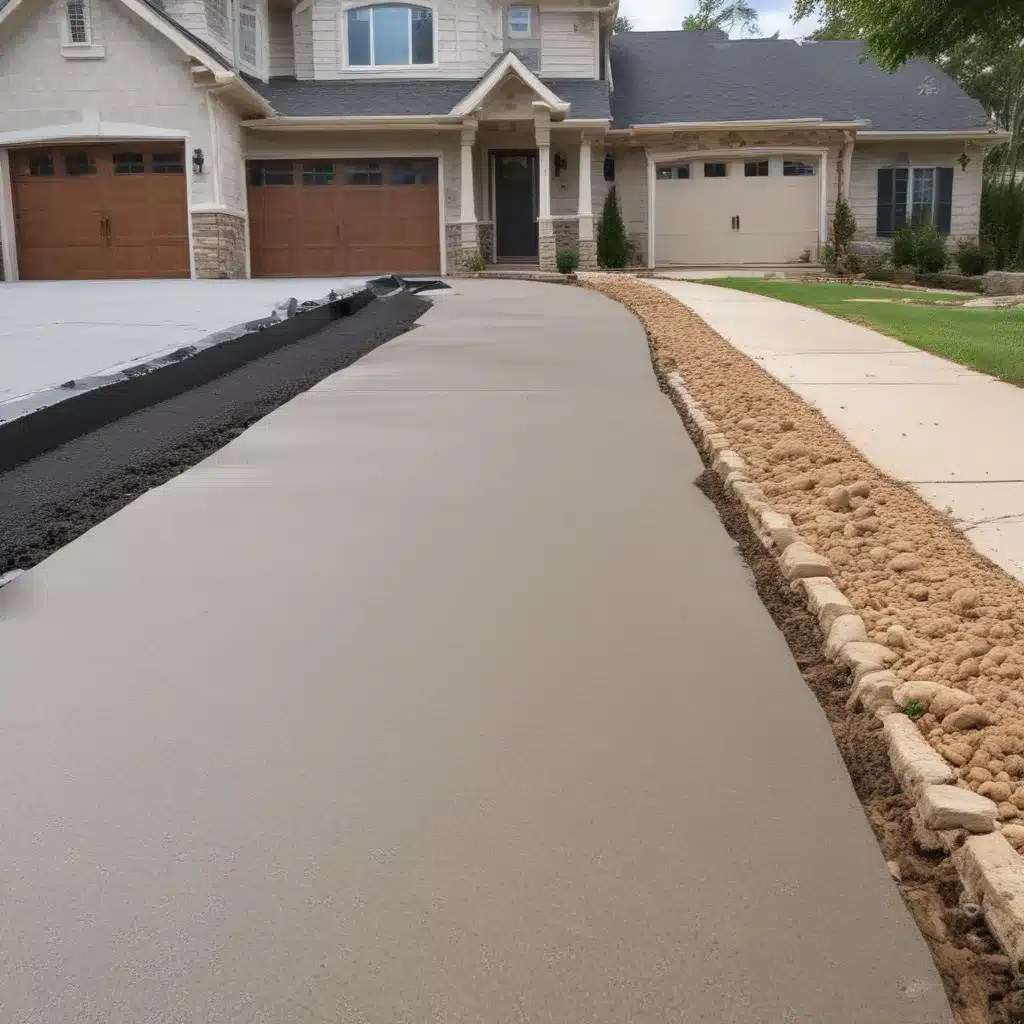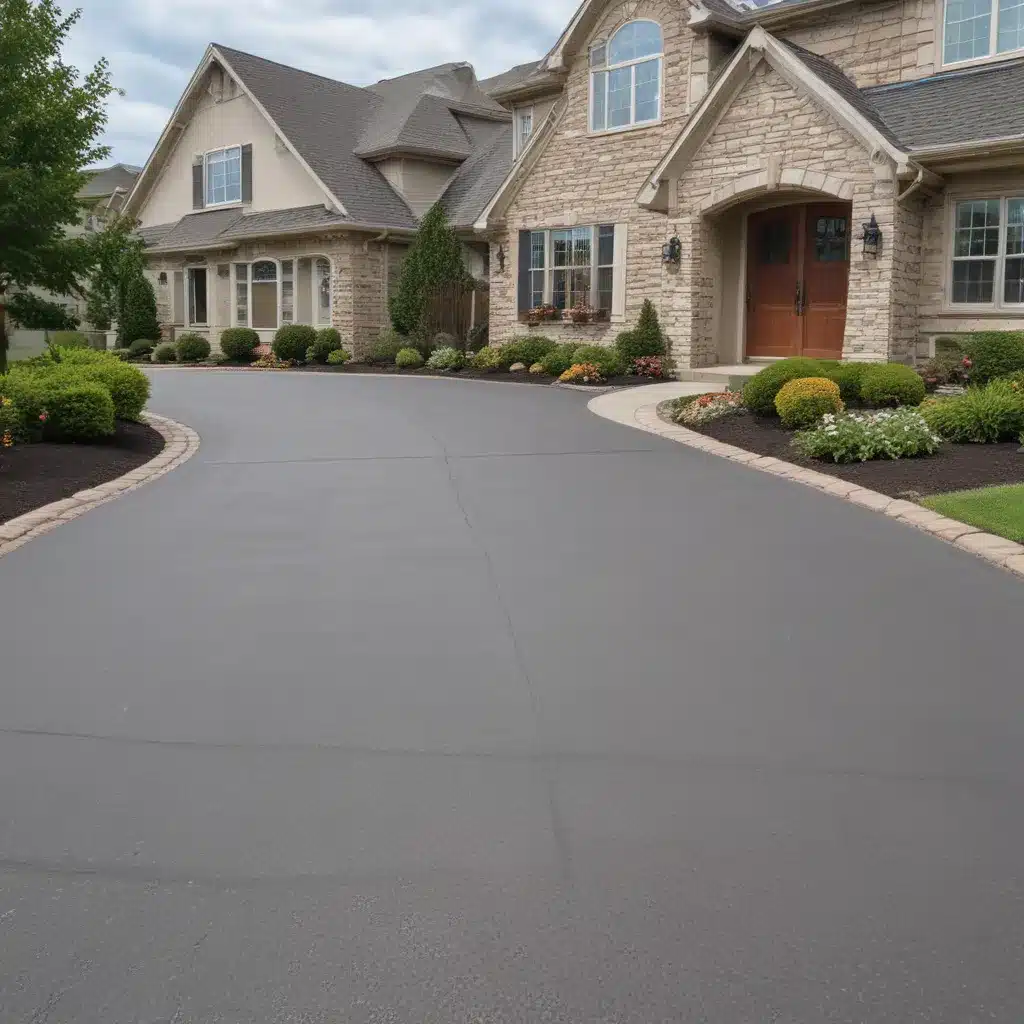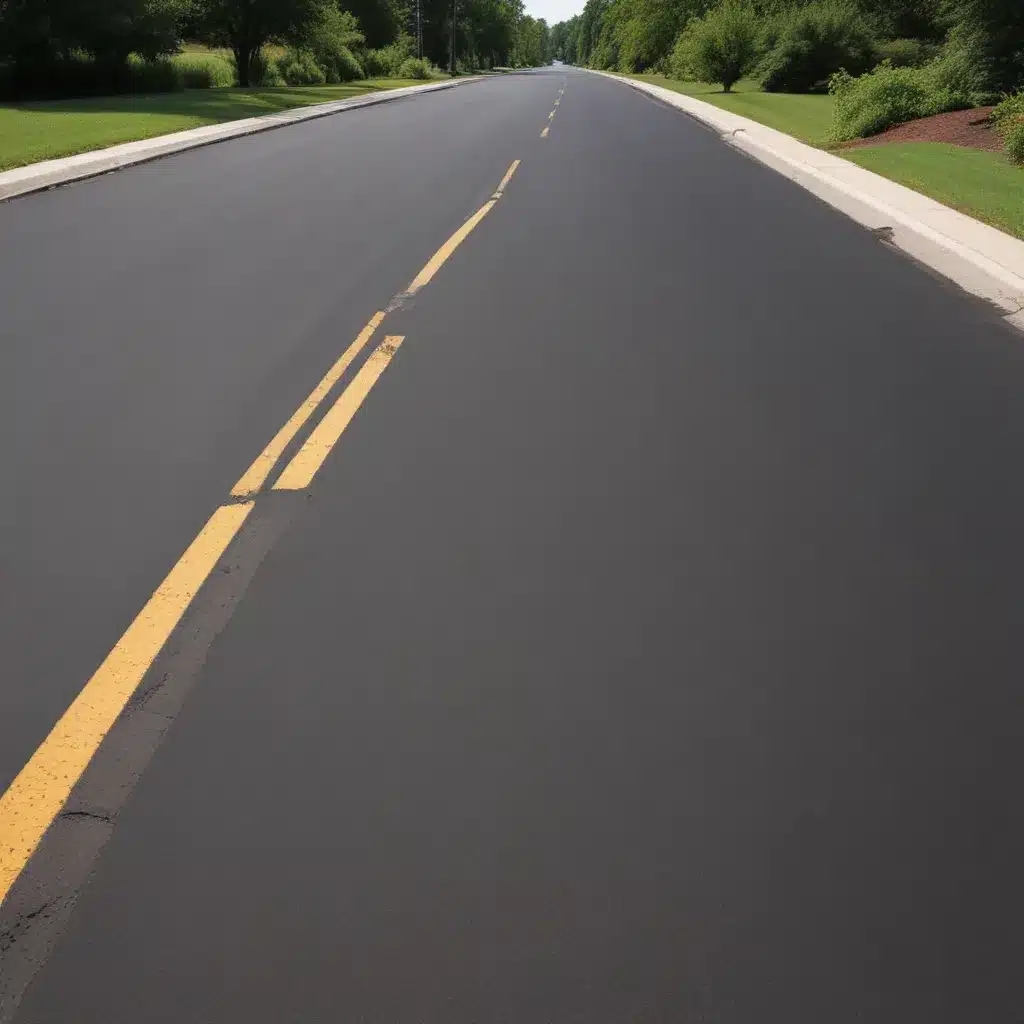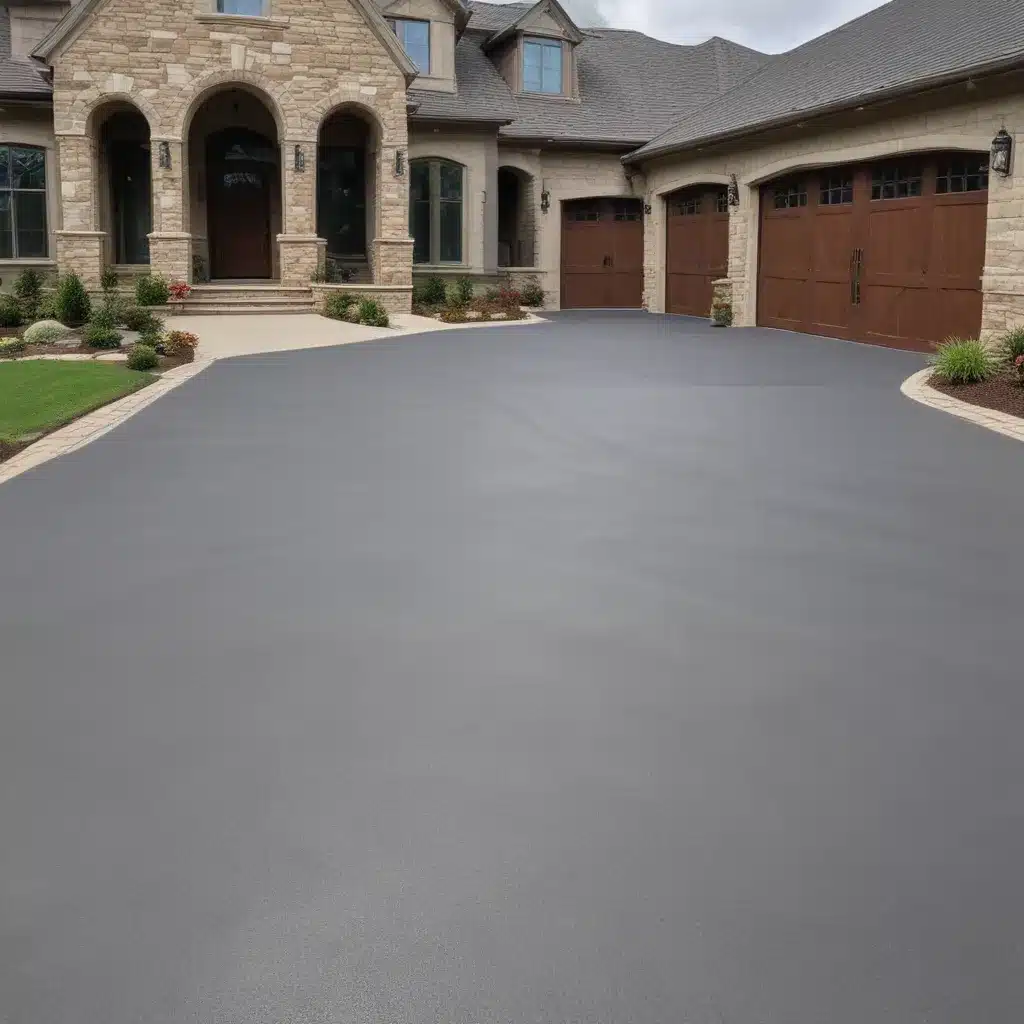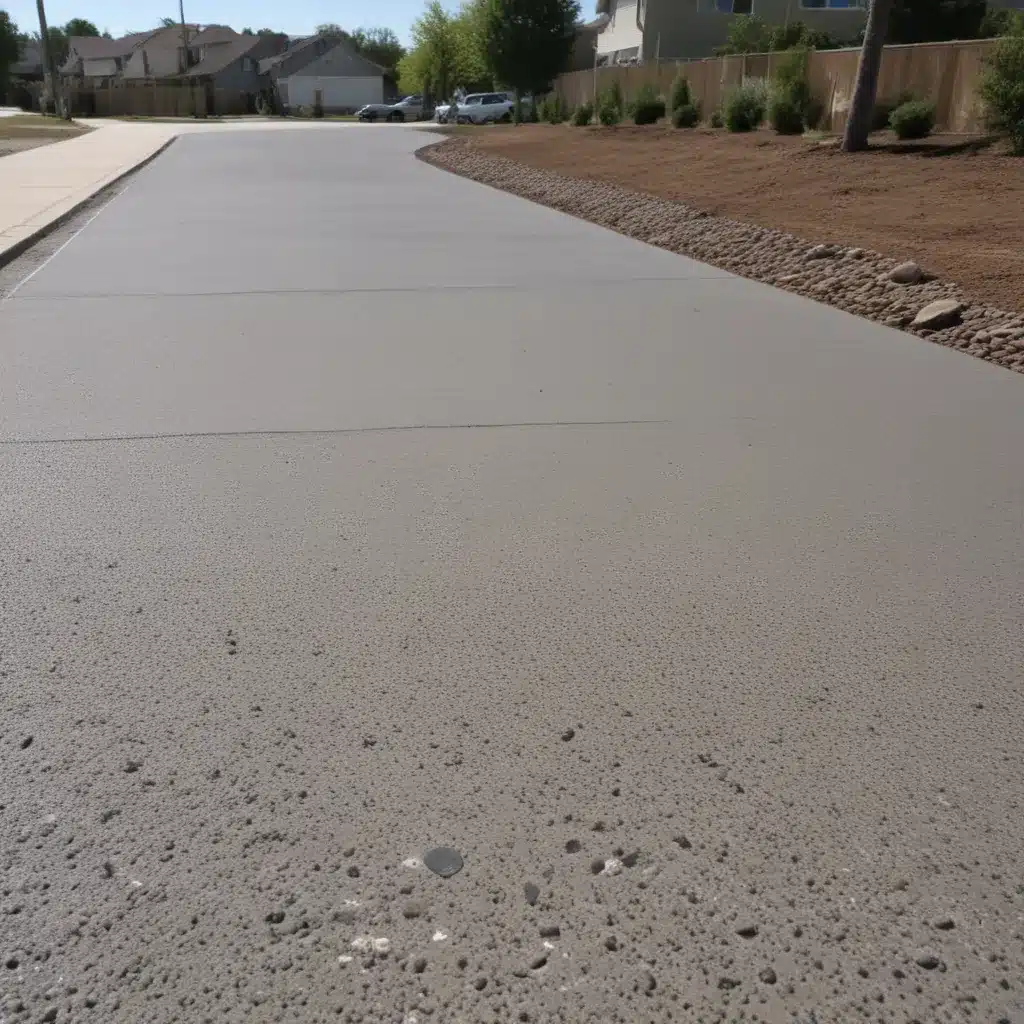Avoiding the Puddle Predicament: A Comprehensive Guide to Proper Driveway Drainage
When it comes to driveway maintenance, one of the most overlooked aspects is often the dreaded driveway drainage system. As someone who’s been in the driveway business for over a decade, I’ve seen it all – from homeowners battling constant pooling to those who’ve mastered the art of effective drainage. Let me tell you, getting it right the first time can save you a world of headache (and money) down the line.
You see, a properly designed and installed driveway drainage system is the unsung hero of a functional, long-lasting driveway. It’s the secret ingredient that whisks away excess water, preventing costly damage to your investment. Imagine the frustration of watching your brand new driveway turn into a skating rink every time it rains. Or the annoyance of trudging through ankle-deep puddles just to get to your car. Not a pretty picture, is it?
That’s why in this comprehensive guide, I’m going to walk you through everything you need to know to get driveway drainage right the first time. We’ll dive into the common drainage issues homeowners face, the key components of a well-designed system, and expert tips to ensure your driveway stays high and dry for years to come. By the end, you’ll be armed with the knowledge to make informed decisions and avoid those wet, worrisome woes.
Understanding Driveway Drainage Challenges
Let’s start by acknowledging the elephant in the room – driveway drainage problems are all too common. In fact, I’d venture to say that most homeowners will encounter some form of drainage issue during the lifetime of their driveway. The reasons behind these problems are varied, but often boil down to a few key culprits:
Improper Grading: One of the most frequent culprits is improper grading. If your driveway isn’t sloped or angled correctly, water will have nowhere to go but straight into the wrong places. Imagine trying to pour water uphill – it just doesn’t work. Proper grading is crucial for directing water away from your home’s foundation and towards designated drainage points.
Clogged Drainage Channels: Another common problem is clogged drainage channels. Over time, leaves, twigs, and other debris can accumulate in your driveway’s gutters, troughs, or catch basins, effectively blocking the flow of water. This can lead to standing water and all the headaches that come with it.
Inadequate Drainage Infrastructure: Sometimes, the problem lies in the driveway’s drainage infrastructure itself. If the system is not properly designed or installed, with the right pipe sizes, slopes, and outlet points, it simply won’t be able to handle the volume of water it needs to manage.
Changing Landscaping: Homeowners’ landscaping choices can also contribute to drainage issues. Adding new flower beds, trees, or even a shed can alter the natural water flow and overwhelm an otherwise well-designed drainage system.
The good news is that with the right knowledge and a proactive approach, these drainage woes can be avoided altogether. Let’s dive into the key components of a well-designed driveway drainage system.
Essential Elements of Effective Driveway Drainage
When it comes to driveway drainage, there are several essential elements that work together to create a robust and reliable system. Understanding these components is crucial for ensuring your driveway stays high and dry, no matter the weather conditions.
Grading and Sloping: As we touched on earlier, proper grading and sloping are the foundation of a well-designed driveway drainage system. The driveway should be angled or sloped away from your home’s foundation, with a gradient of at least 1% to 2% to encourage water runoff. This ensures that water flows away from your home and towards designated drainage points, like catch basins or swales.
Drainage Channels: Strategically placed drainage channels, such as gutters, troughs, or curbs, play a crucial role in directing water flow. These channels should be designed to intercept water before it has a chance to pool on the surface of your driveway. The size, depth, and slope of these channels are all important factors to consider.
Catch Basins and Drain Pipes: Catch basins are the workhorses of a driveway drainage system. These sturdy structures, typically made of concrete or plastic, are installed at strategic locations to collect and funnel water into the underground drainage network. Connected to these catch basins are drain pipes, which carry the water away from your driveway and towards a designated outlet, such as a storm sewer or retention pond.
Outlet Points: The final piece of the puzzle is the outlet points, where the water from your driveway drainage system is safely and responsibly discharged. These could be municipal storm sewers, retention ponds, or even dry wells designed to gradually disperse the water into the ground. Choosing the right outlet point is crucial for avoiding issues like erosion, flooding, or even legal problems with your local authorities.
Now, you might be thinking, “Wow, that’s a lot of moving parts!” And you’d be right. Effective driveway drainage is not a simple one-size-fits-all solution. Each driveway and property is unique, with its own set of challenges and requirements. That’s why it’s so important to work with a reputable and experienced driveway contractor who can assess your specific needs and design a custom drainage system tailored to your property.
Expert Tips for Flawless Driveway Drainage
As someone who’s seen it all in the world of driveway drainage, I’ve learned a thing or two about what it takes to get it right the first time. Here are some of my top tips to ensure your driveway stays high and dry for years to come:
Understand Your Property’s Topography: Before you even start planning your driveway, take the time to thoroughly assess your property’s natural slope, drainage patterns, and any potential problem areas. This will give you a better understanding of how water flows across your land, allowing you to design a drainage system that works with, rather than against, the lay of the land.
Consult with Professionals: When it comes to driveway drainage, DIY is not the way to go. Engaging the expertise of a reputable driveway contractor or civil engineer can make all the difference. They’ll be able to conduct a comprehensive site assessment, design a custom drainage solution, and ensure it’s installed correctly from the start.
Prioritize Proactive Maintenance: Remember, even the best-designed driveway drainage system requires ongoing maintenance to keep it functioning at its best. Make a habit of regularly inspecting and clearing your gutters, catch basins, and other drainage components of any accumulated debris. A little preventative care can go a long way in avoiding costly repairs down the line.
Consider Permeable Paving Options: If you’re in the market for a new driveway, consider opting for a permeable paving solution, such as porous concrete or interlocking pavers. These types of surfaces allow water to infiltrate the ground rather than pooling on the surface, reducing the need for complex drainage infrastructure.
Don’t Forget About Landscaping: As we touched on earlier, changes to your landscaping can have a significant impact on your driveway’s drainage performance. When planning any new garden beds, trees, or other features, be mindful of how they might affect the flow of water and adjust your drainage system accordingly.
By keeping these expert tips in mind, you’ll be well on your way to creating a driveway drainage system that works seamlessly, year after year. And let’s not forget the added bonus of a driveway that stays dry and inviting, no matter the weather. After all, who doesn’t love the satisfaction of pulling into a puddle-free driveway?
Real-Life Drainage Dilemmas and Solutions
Now, let’s take a look at a few real-life examples of driveway drainage challenges and how they were resolved:
The Case of the Flooded Forecourt: The owners of a newly constructed home in a suburban neighborhood were dismayed to find that their driveway was turning into a veritable swimming pool every time it rained. The culprit? Improper grading. The driveway had been installed with a slight slope towards the house, rather than away from it, causing water to pool dangerously close to the foundation.
To remedy the situation, the homeowners enlisted the help of a driveway contractor who specializes in drainage solutions. After a thorough assessment, the contractor recommended regrading the driveway with a gentle 2% slope away from the house, as well as installing a series of strategically placed catch basins and drain pipes to channel the water away. The transformation was nothing short of miraculous, with the driveway now staying dry and the homeowners breathing a sigh of relief.
The Curious Case of the Clogged Culvert: In a rural setting, the owners of a picturesque country home were puzzled by the persistent pooling of water on their driveway, even after heavy rainfalls had passed. After some investigation, they discovered that the issue was caused by a clogged culvert – a small underground pipe designed to allow water to flow freely beneath the driveway.
Over time, leaves, twigs, and other debris had accumulated, effectively blocking the culvert and preventing the water from draining properly. The solution? A good old-fashioned culvert cleaning. The homeowners enlisted the help of a local landscaping crew, who used high-powered water jets to clear out the blockage. Within a matter of hours, the water was flowing freely once again, and the driveway was left high and dry.
A Driveway Drainage Makeover: In a bustling suburban neighborhood, the owners of a well-established home decided it was time to give their aging driveway a much-needed facelift. But they knew that simply repaving the surface wouldn’t be enough – they needed to address the underlying drainage issues that had plagued them for years.
Working closely with a reputable driveway contractor, the homeowners developed a comprehensive drainage plan that included regrading the driveway, installing a series of catch basins and drain pipes, and even incorporating a permeable paving solution to allow water to infiltrate the ground. The transformation was nothing short of remarkable, with the driveway not only looking brand new but also staying dry and functional, even during the heaviest downpours.
These real-life examples serve as a testament to the importance of getting driveway drainage right the first time. By addressing the underlying issues and implementing a well-designed drainage system, homeowners can enjoy the peace of mind of a driveway that stays high and dry, no matter what Mother Nature throws their way.
Conclusion: The Dry Driveway Difference
As you can see, getting driveway drainage right is no small feat, but it’s an investment that pays off in spades. By understanding the common drainage challenges, familiarizing yourself with the key components of an effective system, and heeding the advice of seasoned experts, you can ensure your driveway stays high and dry for years to come.
Remember, a properly designed and maintained driveway drainage system isn’t just about keeping your feet dry – it’s about protecting your investment, preventing costly repairs, and enjoying the hassle-free functionality of a driveway that’s always ready for action. Whether you’re building a new driveway or revamping an existing one, make sure drainage is at the top of your priority list.
And let’s not forget the added aesthetic benefits of a well-drained driveway. No more unsightly puddles or mud pits to mar the curb appeal of your home. Instead, you’ll have a sleek, inviting entryway that welcomes you and your guests with open (and dry) arms.
So, what are you waiting for? Take the plunge and get your driveway drainage right the first time. Trust me, your future self will thank you. And who knows, you might even find yourself bragging to your neighbors about your puddle-free paradise of a driveway. After all, nothing quite compares to the satisfaction of a job well done when it comes to driveway maintenance.

